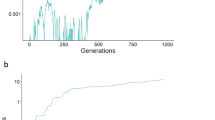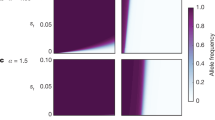Abstract
Trivers1 has suggested that where genetic or developmental constraints on the expression of a trait prevent male and female fitnesses from being maximized simultaneously, female mating preferences should evolve to favour males who exhibit variants of the trait that confer relatively low fitness on males but relatively high fitness on females. This asymmetry is expected because alleles that affect mating preferences are expressed only in females, but are genetically correlated with alleles that differentially affect the fitnesses of the two sexes. Here we describe a two-locus population–genetic model that embodies this idea. The model's qualitative behaviour is exactly like that of previous models2–10 for the joint evolution of male traits and female mating preferences: evolution is equally likely to proceed in either direction along (or away from) a line of neutral equilibria that relates given frequencies of the preference alleles to corresponding frequencies of the trait alleles. But there is a quantitative asymmetry, of the expected kind, in the shape of the line of equilibria. When we extend the model to include migration between partially isolated demes (breeding groups), ‘selective diffusion’11,12 moves the demes along the line of equilibria in the direction that increases average female fitness while lowering average male fitness.
This is a preview of subscription content, access via your institution
Access options
Subscribe to this journal
Receive 51 print issues and online access
$199.00 per year
only $3.90 per issue
Buy this article
- Purchase on Springer Link
- Instant access to full article PDF
Prices may be subject to local taxes which are calculated during checkout
Similar content being viewed by others
References
Trivers, R. Social Evolution (Benjamin/Cummings, Menlo Park, 1985).
Fisher, R. A. The Genetical Theory of Natural Selection (Clarendon, Oxford, 1930).
O'Donald, P. Genetic Models of Sexual Selection (Cambridge University Press, 1980).
Lande, R. Proc. natn. Acad. Sci. U.S.A. 78, 3721–3725 (1981).
Lande, R. Evolution 36, 213–223 (1982).
Kirkpatrick, M. Evolution 36, 1–12 (1982).
Kirkpatrick, M. Am. Nat. 125, 788–810 (1985).
Seger, J. Evolution 39, 1185–1193 (1985).
Engen, S. & Saether, B.-E. J. theor. Biol. 117, 277–289 (1985).
Lande, R. & Arnold, S. J. J. theor. Biol. 117, 651–664 (1985).
Wright, S. Ecology 26, 415–419 (1945).
Wright, S. Evolution and the Genetics of Populations Vol. 3 (University of Chicago Press, 1977).
Janetos, A. C. Behav. Ecol. Sociobiol. 7, 107–112 (1980).
Parker, G. A. in Mate Choice (ed. Bateson, P.) 141–166 (Cambridge University Press, 1983).
Owen, A. R. G. Heredity 7, 97–102 (1953).
Haldane, J. B. S. Nature 193, 1108 (1962).
Li, C. C. Evolution 17, 493–496 (1963).
Bodmer, W. F. Genetics 51, 411–424 (1965).
Kidwell, J. F. et al. Genetics 85, 171–183 (1977).
Wade, M. J. Q. Rev. Biol. 53, 101–114 (1978).
Uyenoyama, M. & Feldman, M. W. Theor. Popul. Biol. 17, 380–414 (1980).
Wilson, D. S. A. Rev. Ecol. Syst. 14, 159–187 (1983).
Wilson, D. S. & Colwell, R. K. Evolution 35, 882–897 (1981).
Mayr, E. in Sexual Selection and the Descent of Man 1871–1971 (ed. Campbell, B.) 87–104 (Aldine, Chicago, 1972).
Zahavi, A. J. theor. Biol. 53, 205–214 (1975).
Trivers, R. L. Evolution 30, 253–269 (1976).
Bell, G. Evolution 32, 872–885 (1978).
Eshel, I. J. theor. Biol. 70, 245–250 (1978).
Borgia, G. in Sexual Selection and Reproductive Competition in Insects (eds Blum, M. S. & Blum, N. A.) 19–80 (Academic, New York, 1979).
Andersson, M. Biol J. Linn. Soc. 17, 375–393 (1982).
Hamilton, W. D. & Zuk, M. Science 218, 384–387 (1982).
Dominey, W. J. J. theor. Biol. 101, 495–502 (1983).
Thornhill, R. & Alcock, J. The Evolution of Insect Mating Systems (Harvard University Press, Cambridge, 1983).
Heisler, I. L. Evolution 38, 1283–1295 (1984).
Williams, G. C. Evolution 11, 398–411 (1957).
Comfort, A. The Biology of Senescence 3rd edn(Elsevier, New York, 1979).
Rose, M. R. Am. Zool. 23, 15–23 (1983).
Andrews, R. M. Copeia 1976, 477–482 (1976).
Stamps, J. A. in Lizard Ecology (eds Huey, R. B., Pianka, E. R. & Schoener, T. W) 169–204 (Harvard University Press, Cambridge, 1983).
Author information
Authors and Affiliations
Rights and permissions
About this article
Cite this article
Seger, J., Trivers, R. Asymmetry in the evolution of female mating preferences. Nature 319, 771–773 (1986). https://doi.org/10.1038/319771a0
Received:
Accepted:
Issue Date:
DOI: https://doi.org/10.1038/319771a0
This article is cited by
-
Mating preferences of selfish sex chromosomes
Nature (2019)
-
Attractive males do not sire superior daughters
Evolutionary Ecology (2010)
-
The evolution of mating preferences and the paradox of the lek
Nature (1991)
-
Female choice for parasite-free male satin bowerbirds and the evolution of bright male plumage
Behavioral Ecology and Sociobiology (1989)
-
Anisogamy, sexual selection, and the evolution and maintenance of sex
Evolutionary Ecology (1987)
Comments
By submitting a comment you agree to abide by our Terms and Community Guidelines. If you find something abusive or that does not comply with our terms or guidelines please flag it as inappropriate.



